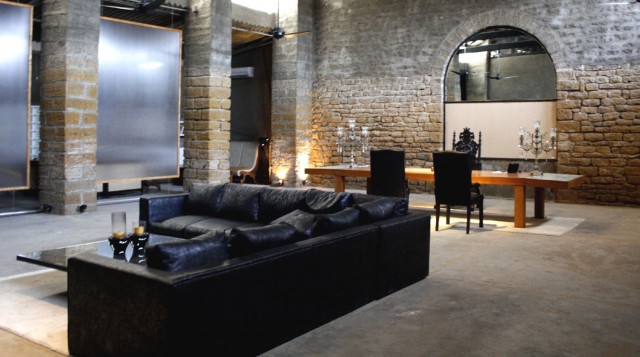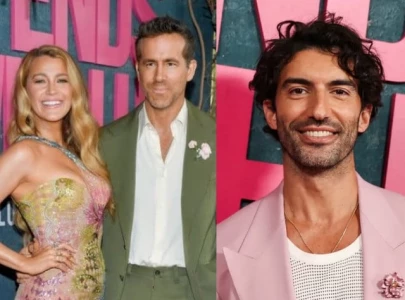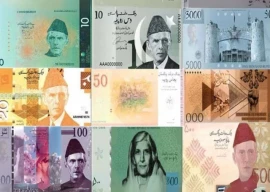
His office reminds me of a swanky New York apartment. In his fingers, intertwined between the many large metallic cocktail rings is a slim beeri, from which wafts a dreamy, smoky smell all over his modern space. Qureshi loves Pakistan. That fact is hard to miss with his extravagant getup, photographs that clutter his desk and the books that line his wall. He claims that is also why he came back the minute he was summoned. He knew that with his degree in farming he could help his family manage their lands, and on the side create a space to do what he loves: designing and photography.
He ended up creating the YBQ Concept Studio, which is located in the Artists Commune. The large warehouse space that he owns near Karachi’s industrial centre has been transformed into a powerhouse of sorts. It contains the commune, a space for events, art exhibitions, performances etc. It includes the YBQ design studio, where he designs everything from logos to furniture, the YBQ printing press, the YBQ photo studio and a salon run by Nabila. “Everything I need, or want or desire is here,” explains Qureshi walking me through the large space, “I hate being dependent on anyone but myself for anything so here it is. Now we’re only missing a restaurant, a production house, an editing suite and a boutique hotel.” As we walk by his boutique he picks up metal coins he designed himself, somewhat like the old 10 paisa ones, except these say Pakistan on one side and the other says Proudly Made in Pakistan with a YBQ logo.
YBQ first made his presence felt in the Pakistani fashion scene a year ago. His first fashion show was a short film, which he directed and produced himself, an intriguing visual display of his clothes worn by two celebrities who flaunted his designs with their movements, every one of which had a meaning. “A lot of people loved it but most of them didn’t get it,” he explains. “ They wanted the girls, the ramp…they told me this isn’t a fashion show.” When he designed his next collection, Holey, people were surprised at the lack of embroidery on his clothes. “My clothes are sculptural pieces, I don’t do embroidery and people were like ‘what the hell is this?” The mannequins you see hanging from the ceilings of his Karachi studio aren’t just the typical everyday mannequins that you would see in a storefront. They, like his clothes, are sculptural works of art. “They are body casts of real women that I know, that I have made with plaster and fibre glass. It wasn’t easy to find women who would do it, but I didn’t want the petite model to be the one who displayed my clothes.” Not surprisingly he has garnered a reputation for eccentricity, of which is he is aware of but not at all ashamed.
Twice a week Qureshi goes to this ancestral village of Mirpur Sakro passing judgements on land disputes and gang rapes, doing rounds of the lands on his horse, planting trees and listening to qawalli with the village men at night. The rest of the week he is at the Commune, guiding students, artists and designers; practically anyone who wants to learn. He works on his collections, caters to his clients and returns home to his wife who wears a burqa and a veil. “We’re two poles apart,” he says about his wife who runs a charity hospital in Lalukhait, “we don’t see eye to eye religiously but again she respects what I believe in and I respect what she believes in.” He admits laughingly that when he attempts to design clothes for her she often puts them down claiming they are too nanga, but he tries anyway.
Does he ever get confused? “Since I’ve discovered myself in my late twenties, I’ve been pretty clear,” he explains, “I’m still discovering, but I know what my heart desires and I know what I’m thinking. I’ve kept them separate.” YBQ though is comfortable in each aspect of his life, in every role that he plays. He switches states of mind like a chameleon and is fully present in every moment of his life. This quality, of owning different roles is also visible in the work he does. While his clothes are cut and sewn flawlessly, his sculptures too are works of art, like the headgear he designed for his friend Shakeel Saigol for fashion week, which made waves across the fashion world. His photographs have been published in Vogue and National Geographic, while his art work has graced the covers of Pakistani books.
“To me the idea of an artist was once a foreign idea,” Qureshi explains, “ but these experiences have helped me recognise the artist that was always within me. Inside of me I know what I am and who I am. I am an artist.”
Published in The Express Tribune, July 4th, 2010.



1737442119-0/BeFunky-collage-(12)1737442119-0-165x106.webp)
1737416356-0/Trump-(9)1737416356-0-165x106.webp)


1737680586-0/Hamza-(1)1737680586-0-270x192.webp)






1737614355-0/Express-Tribune-(1)1737614355-0-270x192.webp)








COMMENTS (1)
Comments are moderated and generally will be posted if they are on-topic and not abusive.
For more information, please see our Comments FAQ